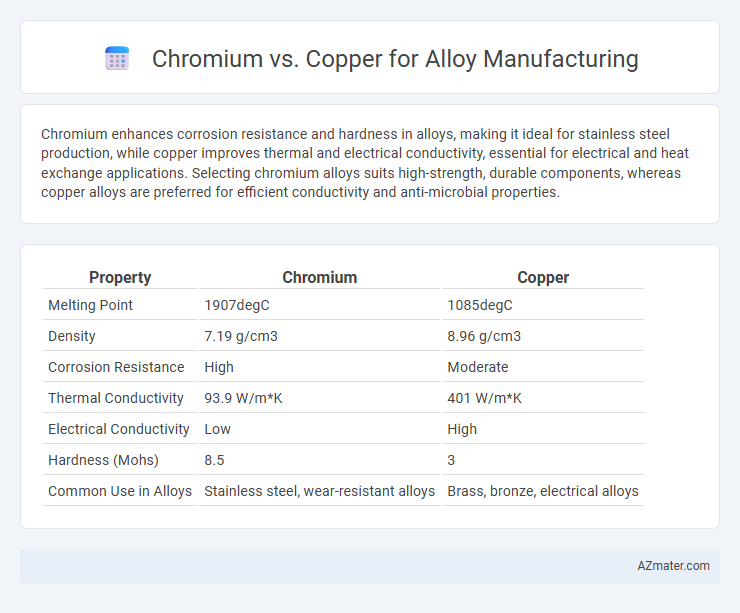Chromium enhances corrosion resistance and hardness in alloys, making it ideal for stainless steel production, while copper improves thermal and electrical conductivity, essential for electrical and heat exchange applications. Selecting chromium alloys suits high-strength, durable components, whereas copper alloys are preferred for efficient conductivity and anti-microbial properties.
Table of Comparison
| Property | Chromium | Copper |
|---|---|---|
| Melting Point | 1907degC | 1085degC |
| Density | 7.19 g/cm3 | 8.96 g/cm3 |
| Corrosion Resistance | High | Moderate |
| Thermal Conductivity | 93.9 W/m*K | 401 W/m*K |
| Electrical Conductivity | Low | High |
| Hardness (Mohs) | 8.5 | 3 |
| Common Use in Alloys | Stainless steel, wear-resistant alloys | Brass, bronze, electrical alloys |
Overview of Chromium and Copper in Alloy Manufacturing
Chromium is a key element in alloy manufacturing due to its exceptional corrosion resistance, hardness, and ability to enhance stainless steel's strength and durability. Copper contributes excellent electrical and thermal conductivity, along with superior malleability, making it essential for brass and bronze alloys used in electrical, marine, and decorative applications. Both metals are critical in creating alloys that balance mechanical performance, corrosion resistance, and conductivity for diverse industrial uses.
Chemical Properties and Reactivity
Chromium exhibits high corrosion resistance and forms a stable oxide layer, making it ideal for enhancing alloy durability in harsh chemical environments. Copper offers excellent electrical conductivity and antimicrobial properties but is more prone to oxidation and corrosion compared to chromium. The differing reactivities influence alloy applications, with chromium alloys favored for structural resistance and copper alloys for conductivity and thermal management.
Mechanical Strength and Durability Comparison
Chromium enhances alloy mechanical strength by increasing hardness and resistance to wear, contributing to superior durability in high-stress applications. Copper alloys provide excellent corrosion resistance and thermal conductivity but generally exhibit lower tensile strength compared to chromium-containing alloys. The integration of chromium in alloys results in improved fatigue resistance and longer service life under demanding mechanical loads.
Corrosion Resistance Capabilities
Chromium significantly enhances corrosion resistance in alloys by forming a stable, passive oxide layer that protects metals from rust and environmental degradation. Copper alloys exhibit moderate corrosion resistance, especially in marine and acidic environments, due to copper's natural ability to inhibit microbial growth and oxidation. Combining chromium with copper in alloys optimizes durability and resistance against corrosive elements in industrial applications.
Heat and Electrical Conductivity
Chromium exhibits lower electrical and thermal conductivity compared to copper, making it less efficient in applications requiring high heat dissipation or electrical transmission. Copper is widely preferred in alloy manufacturing for its superior electrical conductivity of approximately 5.96 x 10^7 S/m and thermal conductivity around 400 W/m*K. Incorporating chromium into copper alloys often enhances corrosion resistance and hardness but reduces overall conductivity, necessitating a balance based on specific engineering requirements.
Common Alloy Applications
Chromium and copper serve distinct roles in alloy manufacturing, with chromium primarily used to enhance hardness, corrosion resistance, and wear resistance in stainless steels and tool steels. Copper alloys, such as brass and bronze, are favored for their excellent electrical conductivity, corrosion resistance, and antimicrobial properties, making them ideal for electrical components, plumbing, and marine applications. The choice between chromium and copper depends on the desired mechanical properties and environmental performance of the final alloy product.
Cost Factors and Availability
Chromium offers higher corrosion resistance and strength, but its cost is significantly influenced by limited global reserves and complex extraction processes, leading to price volatility. Copper is more abundant and cheaper, making it a cost-effective choice for alloy manufacturing, especially in large-scale applications. Availability of copper remains stable due to widespread mining, while chromium supply can fluctuate, affecting overall alloy production expenses.
Environmental and Health Considerations
Chromium and copper alloys differ significantly in environmental impact and health risks during manufacturing. Chromium, especially hexavalent chromium, poses serious respiratory hazards and requires stringent controls to prevent toxic exposure, while copper alloys generally emit fewer airborne contaminants but can cause skin irritation and metal fume fever if improperly handled. Sustainable alloy manufacturing increasingly favors copper for its lower toxicity and easier recycling processes, though regulatory compliance and protective measures remain critical for both metals to minimize occupational hazards and ecological damage.
Recent Innovations in Alloy Development
Recent innovations in alloy development highlight the distinct roles of chromium and copper in enhancing material properties. Chromium is primarily used for its corrosion resistance and hardness, significantly improving stainless steel and superalloys' durability in extreme environments. Copper innovations focus on improving electrical conductivity and thermal performance, with recent alloys exhibiting enhanced flexibility and resistance to oxidation.
Selecting the Optimal Element for Specific Alloys
Chromium enhances corrosion resistance and hardness in stainless steel alloys, making it ideal for applications requiring durability and oxidation resistance. Copper improves electrical conductivity and corrosion resistance in marine and architectural alloys, offering superior performance in environments exposed to saltwater or atmospheric conditions. Selecting between chromium and copper depends on balancing mechanical strength, corrosion resistance, and conductivity to meet specific alloy performance requirements.

Infographic: Chromium vs Copper for Alloy Manufacturing
 azmater.com
azmater.com